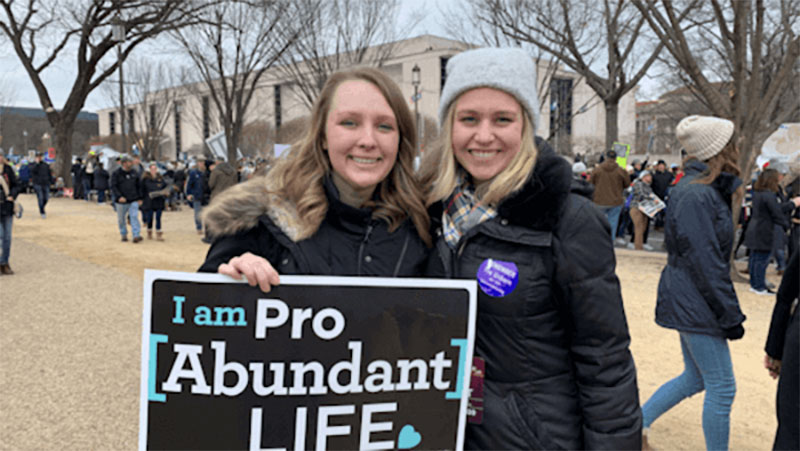
This year promises to hold seismic shifts in the cultural, spiritual, and legal battles over abortion, so let us prepare to face these challenges with prudence, courage, and faith.
The most consequential Pro-Life development of last year was the Supreme Court of the United States agreeing to hear arguments in the Dobbs v. Jackson case. This case could be the vehicle to overturn or drastically reign in the two most deadly rulings in our country’s history: Roe v. Wade and Planned Parenthood v. Casey. The second development is the passage of the Texas Heartbeat Act, which has saved thousands of preborn lives already, and has served as a beacon of light for how our country can move into a post-Roe era.
Is Roe Finally Over?
On May 17, 2021, the Supreme Court of the United States announced that they would hear a case that challenges the core tenets of previous rulings on elective abortion and how far states could go to protect life.
The case, Dobbs v. Jackson Women’s Health Organization, is a challenge the abortion industry brought against a Pro-Life Mississippi law that prohibits elective abortions after 15 weeks’ gestation. Jackson Women’s Health Organization, the only abortion provider in the state, argued that the law was unconstitutional and should be struck down by the court. The pro-abortion side was absolutely shocked by the unexpected announcement since the case had been sitting before SCOTUS for nearly a year, and the paper work had been distributed and rescheduled for conference more than 20 times.
While experts attempted to explain the timing and logic of the court, the abortion industry and the Pro-Life movement immediately realized the potential significance of this case. The most direct challenge of Roe and Casey since 1973 was going to be heard before a court that had just in recent years been re-shaped by President Donald J. Trump.
For almost 50 years, Roe has perpetrated grave injustice against the nation’s most defenseless. The decision upended our constitutional order, depriving states of their ability to through Republican democracy enact legislation to protect preborn children. When SCOTUS agrees to hear a case, they accept very narrow and specific questions they will answer. In the case of Dobbs, the question a majority of the Justices wanted to more closely examine was “whether all pre-viability prohibitions on elective abortions are unconstitutional.”
The abortion industry argued that the Mississippi Law (and numerous ones like it) was unconstitutional because SCOTUS had previously ruled against Pro-Life laws that impose an undue burden on a mother’s access to abortion if the child cannot survive outside of the womb at that point in the pregnancy. In the 1992 case, Planned Parenthood v Casey, SCOTUS essentially drew an artificial line in a woman’s pregnancy and a preborn child’s development called “viability,” the point at which a child could live on their own outside the womb. States could not ban abortions before this point of viability, which at the time was understood to be around 26-28 weeks gestation. Experts and Pro-Lifers alike immediately knew this logic was legally problematic and morally reprehensible.
The “viability line” is a terrible legal limit since viability in constantly in flux depending on developments in medicine and technology. Also, the point at which a child could survive is entirely dependent upon where the woman goes into preterm labor (e.g. Rural West Texas vs Downtown Houston) and the likelihood of a child surviving on his own outside the womb earlier in pregnancy varies among woman due to health and other factors. So, there is no objective date in pregnancy one can point to as “the moment” of viability, but this type of exactness is necessary to determine which laws banning abortion are allowed and which are not.
More importantly, the “viability line” test is completely contradictory to how we typically think about our moral obligations and responsibilities to other people. When we look at a mother’s ethical responsibility to her children, which child does she owe more to: her newborn daughter or her nineteen-year-old son? Most people, using common moral reasoning would say that the mother has a stronger responsibility to care for her newborn daughter since she is more helpless, fragile, and dependent upon her mother for safety, food, and care. While a mother will always feel a deep sense of obligation to her adult son, that responsibility is lighter since he is more independent, can fend for himself, and is expected to be more self-reliant. The “viability line” that SCOTUS drew in Casey says the opposite. SCOTUS claimed that a mother (and a state) has a lesser moral obligation to those who are more helpless and reliant upon others. If a child is viable and can theoretically survive outside the womb on their own then, yes, a state can ban the violence of abortion against that preborn child. However, under Casey if that child in the womb is not viable and at a stage of development where she is most dependent upon her mother for her life, nutrition, and safety, then states are prohibited from banning abortion and protecting her. This is moral absurdity.
This is why we celebrated SCOTUS looking directly at “whether all pre-viability prohibitions on elective abortions are unconstitutional.” With Dobbs, the Pro-Life movement has the chance to argue SCOTUS should throw out this irrational legal justification for stopping states from passing and enforcing strong Pro-Life laws that would protect preborn children before and after the point of viability.
Dobbs v. Jackson could be the case to dismantle Roe v. Wade and allow state legislatures to protect preborn children. During the arguments, several justices signaled their willingness to do just that. When Mississippi finally made their oral arguments before the court, they boldly and unapologetically advocated for a wholesale reversal of Roe and Casey.
In response, the abortion industry defended the substance of Roe but also emphasized the need to respect the precedent of the court’s prior decisions. The court’s three liberal justices spent their time suggesting Roe is too entrenched, and the abortion issue too political, to reverse the decision. Justice Sonia Sotomayor conceded the Constitution does not expressly mention many of the court’s protected rights but nonetheless concluded the court is the final arbiter on these matters. This assertion is, unsurprisingly, an implicit biased endorsement of judicial supremacy. Justice Elena Kagan, for her part, spent no time defending Roe on the merits. Instead, she concentrated her questions on the importance of respecting precedents.
The conservative justices were openly critical of the viability logic and discussed reasons the court may use to break with erroneous precedent. Justice Kavanaugh, who many believe is the swing justice on the court asked “abortion appears nowhere in the Constitution’s text, history, or tradition. So wouldn’t the court’s most neutral action be to let the legislatures decide?” A neutral ruling, Justice Kavanaugh seemed to imply, is to reverse Roe and take abortion policy out of the courts. This would mean allowing individual states to determine how far they want to go to protect innocent human life.
While Pro-Lifers were ultimately encouraged by the tone of the arguments before SCOTUS in December 2021, we will not officially know their ruling in Dobbs until the summer of 2022. For now, the abortion-industry is preparing as if Roe will finally fall. Accordingly, the left has flooded headlines, news coverage, op-eds, and social media with unsurprising “the sky is falling” rhetoric. However, a Post-Roe world is not as apocalyptic as the abortion industry makes it sound. In fact, we have already had a glimpse of what will happen if Roe and Casey are officially overturned. Just look at Texas.
The Texas Heartbeat Act
On September 1, 2021 something that has not happened since 1973 occurred: a Pro-Life law protecting children as early as six-weeks gestation was enforced and the abortion industry was forced to comply. That was the date that the Texas Heartbeat Act went into effect and around one hundred preborn Texans were spared from the violence of abortion and Texas mothers were directed to more life-affirming options.
In 2021, the Texas State Legislature passed Senate Bill 8, the Texas Heartbeat Act, with bipartisan support. The policy bans elective abortions after the preborn child’s heartbeat is detectable, which typically occurs around six weeks’ gestation. Breaking from the model of a dozen other states that had passed similar laws before, SB 8 is only enforceable through private civil action. This means that all state officials and law enforcement are prohibited from taking any action against the abortion industry if they have reason to believe the law was broken. However, when anyone violates the law by performing, aiding, or abetting an abortion after six weeks, a private citizen may sue the abortionist or abortion industry to enforce the law. This unique enforcement mechanism ended up preventing the abortion industry from successfully challenging the bold Pro-Life law in court.
While the abortion industry filed a flurry of legal challenges (including 14 cases against me personally and Texas Right to Life), and they took those challenges all the way before SCOTUS, the law remained in effect saving lives in Texas daily since September. The state of Texas has been successful in defending the law, however some legal challenges remain unresolved and will continue into 2022.
The biggest lesson in Texas in 2021 for the Pro-Life movement was that Texas was effectively a preview of what a post-Roe world will look like. Texas had four months where 90% of elective abortions were effectively prohibited and stopped, according to the abortion industry themselves. The Texas Pro-Life movement, including adoption agencies, pregnancy centers, maternity homes, and other activists have been functioning in a virtually abortion-free state for a quarter of 2021. The sky has not fallen. The prospect of a Roe being overturned by Dobbs has raised concerns that we may have abortion-free states soon, but we do not have pro-women states ready to step up to serve. However, Texas has proven this talking point wrong. The Pro-Life movement has risen to the occasion in Texas, not just banning abortions but coming alongside women facing unexpected and difficult pregnancies.
One of the ways Texas stood up for women, not just preborn children, was to dedicate over $100 million dollars in the state budget for the “Alternatives to Abortion” program that funds a statewide network of social services for new and expecting parents. Counseling, parenting training, job and life skills classes, and material assistances are all reimbursable services to approved providers under the program. The Texas Alternatives to Abortion program is the largest and most successful state-funded, life-affirming program in the United States. While Pro-Lifers must continue to find new and innovative ways to support women when abortion is not a legal option, Texas shows we are ready for the challenge.
------------------------
Dr. John Seago is Legislative Director of Texas Right to Life.
















